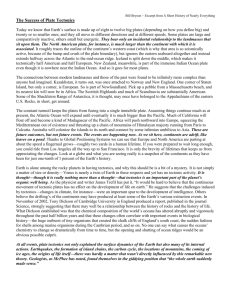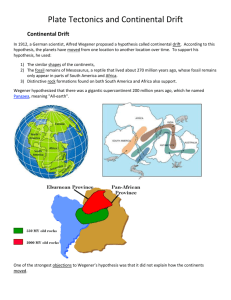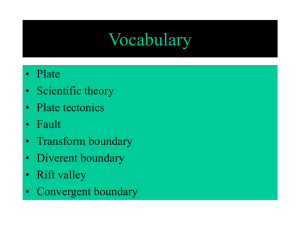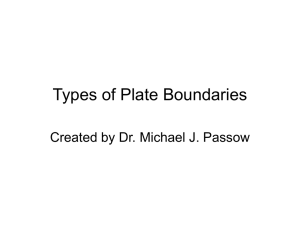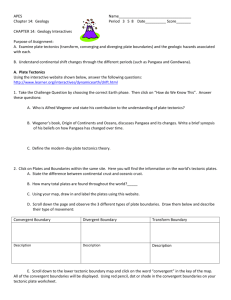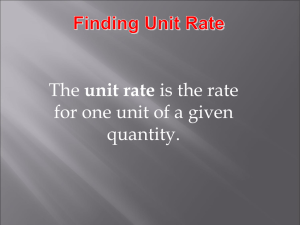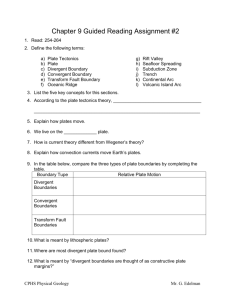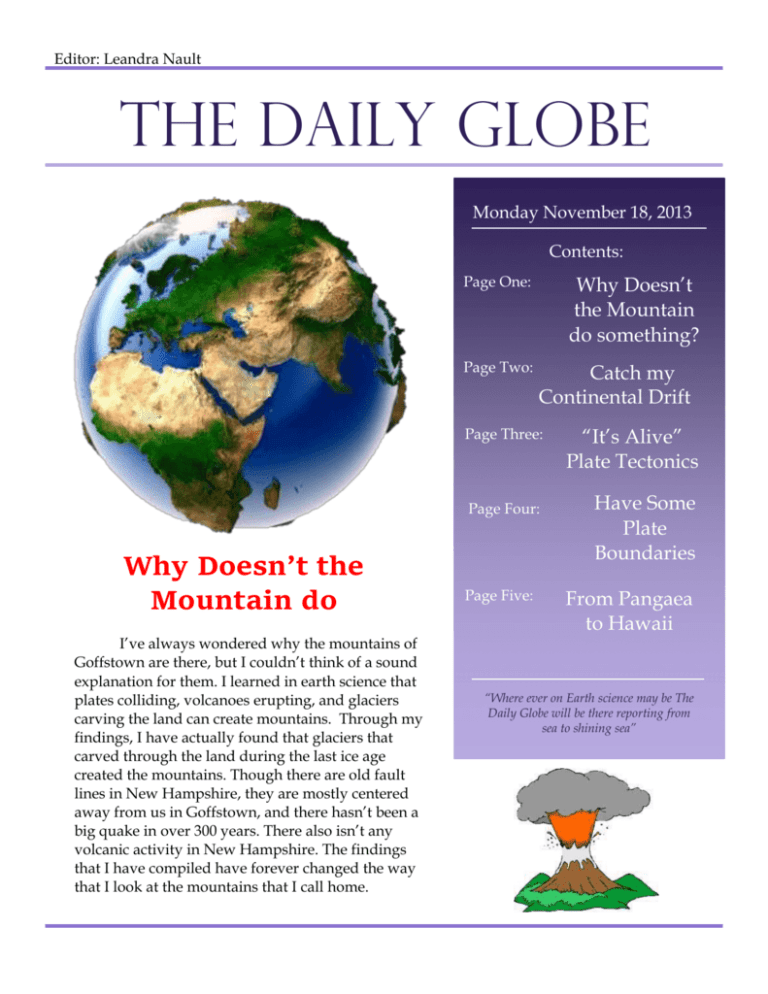
Editor: Leandra Nault
THE DAILY GLOBE
Monday November 18, 2013
Contents:
Page One:
Page Two:
Why Doesn’t
the Mountain
do something?
Catch my
Continental Drift
Page Three:
Page Four:
Why Doesn’t the
Mountain do
something?
I’ve always
wondered why the mountains of
Goffstown are there, but I couldn’t think of a sound
explanation for them. I learned in earth science that
plates colliding, volcanoes erupting, and glaciers
carving the land can create mountains. Through my
findings, I have actually found that glaciers that
carved through the land during the last ice age
created the mountains. Though there are old fault
lines in New Hampshire, they are mostly centered
away from us in Goffstown, and there hasn’t been a
big quake in over 300 years. There also isn’t any
volcanic activity in New Hampshire. The findings
that I have compiled have forever changed the way
that I look at the mountains that I call home.
Page Five:
“It’s Alive”
Plate Tectonics
Have Some
Plate
Boundaries
From Pangaea
to Hawaii
“Where ever on Earth science may be The
Daily Globe will be there reporting from
sea to shining sea”
Catch my
I have recently had the privilege
to
Continental
Drift
interview the man behind continental drift, Alfred
Wegener (Fig. 1). Alfred was a German
astronomer. He was born in Berlin, Germany in
1880 (1, Fig. 2). He told me that he stumbled upon
this thought when he was looking at an atlas in
his library. He said that when he was studying
the continents of Africa and South America he
realized that they seemed to fit together (2). This
was one way he explained his theory. He also told
me that he noticed from fossil records from the
different continents that the same animal had
appeared on different continents (2). Since
through natural selection he knew that the same
species couldn’t of evolved on different
continents he knew that they had to of been
together somehow. Also, through looking at the
fossils he noticed that the glaciers had left the
same movement scratches on rocks in different
continents and that the mountain ranges on
different continents matched up with mountain
ranges on the other side of the ocean (2). The last
thing he told me was that he collected some
ancient climate information and realized that the
northern hemisphere was once near the equator
and the southern hemisphere was once down
near the South Pole (2, Fig. 3). This meant that the
climates had to of been sifted by the continents
being in different places. Sadly Wegener’s
hypothesis on continental drift theory was not
accepted during his lifetime. He died in
November of 1930 at the age of 50 on an
expedition to Greenland (1). But, scientists have
since then found evidence to support his theory
and are using it to make new discoveries about
the earth and its movement.
2
Figure 1. Alfred Wegener (1)
Figure 2. German flag (1)
Figure 3. Pangaea world (2)
“It’s Alive” Plate
Plate tectonics theory is the theory that
Tectonics
deals with the movement of the Earths crust or
lithosphere. The lithosphere rides on top of the
asthenosphere (3). The lithosphere is broken up
into smaller plates called tectonic plates (3, Fig. 1).
The plates don’t all move in the same direction
either. They move in different directions because
of the different types of plate boundaries (3, Fig. 2
and 3). The plates move pretty fast for Earth
spreading approximately five centimeters per
year (3). There are about seven to eight major
plates on the Earth and many smaller plates too.
Plate tectonic theory was a major contributor to
the knowledge gained about Pangaea and
seafloor spreading. The driving force behind
the motion of the plates (Fig. 3) is hot magmatic
convection currents that take place inside the
Earth’s asthenosphere (3). These currents are
formed when cooler rock is subducted near
subduction zones and the heated rock is pushes
through the crust at divergent areas (3). This
circular motion helps to drive the plates in
different directions. Depending on where the
zones are on the plate it will move in different
directions (Fig. 3). That is the basics on the theory
of plate tectonics.
Figure 1. Plate world (3)
Figure 2. Different
boundaries (3)
Figure 3. Earths plate movement (3)
3
Have Some Plate
There are three types of plate boundaries;
Boundaries
these three boundaries are divergent, convergent
and transform (4, Fig. 1). Divergent boundaries
are where plates pull apart from each other and
magma is released though the cracks in the Earth
(4). Divergent boundaries are where you find mid
ocean ridges (5). An example of a divergent
boundary is the mid Atlantic ridge (5).
Convergent boundaries are where two plates meet
and one plate dives under the other (4). At
convergent boundaries, you find volcanoes and
earthquakes. An example of a convergent
boundary is the ring of fire (5). Transform
boundaries are where two plates slide past each
other (4). At transform faults you can find
earthquakes and tremors. An example of a
Transform boundary is the San Andres Fault in
California (5). All of these boundaries seem to be
working separately, but they are really all
working together to move the Earths crust (Fig. 3).
When a divergent boundary pushes two plates
apart the convergent boundary subducts those
two plates in a constant cycle of recycling of the
plates (Fig. 2). Transform boundaries work into
the mix by sliding plates past one another other
(6). The plates are moving at a rate of about 5 cm a
year and the boundaries are helping them on
there magnificent journey (6).
Figure 3. Lithosphere (4)
4
Donec
interdum
Pellentesque:
Figure 1. Different boundaries (4)
Figure 2. Subduction zone (5)
From Pangaea to
The Earth that we live on now wasn’t
Hawaii
always split up into continents like we know
it to be now. There once was a huge land mass
called Pangaea, meaning all Earth, which was
one big super continent (7, Fig.1). Then at
about two billion years ago the great super
continent started to break up into the smaller
continents we have today (7). The continents
kept spreading over time until the continents
became the ones that we are used to today.
The Earths plates are still moving due to plate
boundaries constantly pulling and pushing
the plates (5). The Ring of Fire is a ring of
convergent boundaries that houses most of
Figure 1. Pangaea (7)
Earth’s volcanoes and these volcanoes are some of
the deadliest on Earth (8). The ring of fire encircles
the pacific plate and stretches all the way from
Alaska to the Antarctica (8, Fig. 3). The ring of fire
is a truly magnificent phenomena, which gives
scientists a look into the motions of the Earth’s
plates. There is an area inside the ring of fire,
where a hot spot sits over the island of Hawaii (9).
This hot spot doesn’t move with the plate, in fact
it stays stationary while the Pacific plate moves
over it. This is why there are four Hawaiian
Islands and they are all west of the big island (Fig.
2). The Pacific plate is moving west over the hot
spot and every time it erupts a new island is
created (9). The Earth has made a great journey
Figure 2. Hawaiian islands (9)
Figure 3. The ring of fire (8)
5
"Alfred Wegener." Wikipedia. Wikimedia Foundation, 13 Nov. 2013.
Web. 13 Nov. 2013. (1)
"The Supporting Evidence Of Continental Drift Theory." The
Supporting Evidence Of Continental Drift Theory. N.p., n.d. Web. 13
Nov. 2013. (2)
"Plate Tectonics." Wikipedia. Wikimedia Foundation, 13 Nov. 2013.
Web. 13 Nov. 2013. (3)
"Plate Tectonics : Plate Boundaries." Plate Tectonics : Plate Boundaries.
N.p., n.d. Web. 13 Nov. 2013. (4)
"Plate Tectonics Map - Plate Boundary Map." Plate Tectonics Map.
N.p., n.d. Web. 13 Nov. 2013. (5)
"Earth Floor: Plate Tectonics." Earth Floor: Plate Tectonics. N.p., n.d.
Web. 13 Nov. 2013. (6)
"Pangaea." Wikipedia. Wikimedia Foundation, 13 Nov. 2013. Web. 13
Nov. 2013. (7)
"Ring of Fire." Wikipedia. Wikimedia Foundation, 11 Dec. 2013. Web.
13 Nov. 2013. (8)
"Hawaii Hotspot." Wikipedia. Wikimedia Foundation, 11 May 2013.
Web. 13 Nov. 2013. (9)
Tarbuck, Edward J., Frederick K. Lutgens, and Dennis Tasa. Prentice
Hall Earth Science. Needham, Mass. ; Upper Saddle River, N.J.:
Pearson/Prentice Hall, 2006. N. pag. Print. (10)
7

